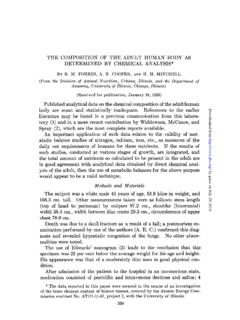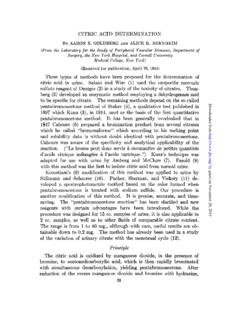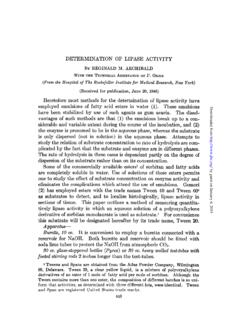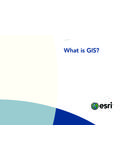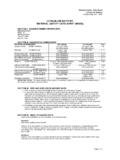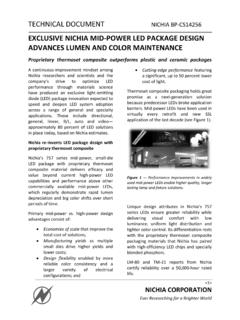Transcription of A SIMPLE AND ACCURATE METHOD FOR THE DETER-
1 A SIMPLE AND ACCURATE METHOD FOR THE DETER- MINATION OF CHLORIDE IN BIOLOGICAL FLUIDS. BY OTTO SCHALES AND SELMA S. SCHALES. (From the Medical Clinic of the Peter Bent Brigham Hospital and the Department ofMedicine, Harvard Medical School, Boston). (Received for publication, July 3, 1941). Several modifications of the classical Volhard METHOD (1) for Downloaded from by guest on September 24, 2018. the determination of chloride have been proposed but none is entirely free from the drawbacks of the original procedure. One of the principal causes of error is that the end-point fades and is uncertain when the silver chloride precipitate is not removed before titration. This is due to the fact that AgCl is more soluble than AgSCN and therefore reacts with thiocyanate: AgCl +. SCN' = AgSCN + Cl'. In order to avoid this reaction and to make an ACCURATE deter- mination possible, AgCl has to be filtered off. This, however, introduces a new error, as, according to Kolthoff (2), a definite loss in silver ions occurs through adsorption on the precipitate.
2 The possibility of retarding the reaction with the precipitate so that the end-point lasts long enough to afford an ACCURATE result was studied by a number of authors, some of them being quoted by Peters and Van Slyke (3). While a satisfactory modification of Volhard's METHOD without removal of the silver chloride has not yet been published, efforts to replace his procedure by methods based on different principles have led to promising results. A number of those newer methods have been investigated and, while many of them give reliable results, only a few are at the same time SIMPLE enough to compete with the traditional Volhard procedure and its modifications. Consequently it has been con- cluded that the mercurimetric determination of chloride offers an especially favorable METHOD for a rapid, SIMPLE , and ACCURATE determination. 879. 880 Determination of Chloride As with silver ions, chloride combines also with mercuric ions according to the equation, 2Cl' + Hg = HgCl,, without, how- ever, forming a precipitate.
3 mercuric chloride is only very slightly dissociated and the end-point of the titration is therefore recognized by the appearance of mercuric ions in the solution. Liebig (4), who discussed the possibility of a mercurimetric determination of chloride, used urea as an indicator. As sodium nitroprusside gives a turbidity with mercuric ions, this was used subsequently by some investigators as an indicator (5-7), but it Downloaded from by guest on September 24, 2018. did not become very popular, as there seems to be a large subjective range in the observation of the appearance of the first turbidity. The situation became more attractive with the introduction by Dubsky and Trtilek (8) of diphenylca'rbazide and diphenyl- carbazone as indicators, forming intensive violet-blue-colored complex salts with mercuric ions. Lang (9) recommended the use of their METHOD for the determination of chloride in blood filtrates. There are, however, several important factors upon which depends the success or failure of the mercurimetric METHOD .
4 Once they are known, they can be easily controlled and as they now have been worked out in detail, a METHOD has been developed which is ACCURATE and free from technical difficulties. EXPERIMENTAL. Reagents- mercuric nitrate solution. to gm. of mercuric nitrate ( Baker's Analyzed) are dissolved in a few hundred ml. of mater with the addition of 20 ml. of 2 N HNOS. The solution is made up with water to 1000 ml. Indicator. 100 mg. of diphenylcarbazone (Eastman Kodak No. 4459) are dissolved in 100 ml. of 95 per cent alcohol and stored in the dark, preferably in a refrigerator. Chloride standard. Sodium chloride is dried at 120' and mg. are dissolved in water and made up to 1000 ml. The solution contains 10 milliequivalents of chloride per liter. It is used for the standardization of each new bat,ch of mercuric nitrate solution. 0. Schales and 8. S. Schales 881. Procedure Protein-Free Solutions-The following procedure is used for the determination of chloride in Folin-Wu filtrates of serum or blood.
5 This technique may be used on other fluids with low protein content. To 2 ml. of filtrate (= ml. of serum) in a 25 ml. TABLE I. Standardization 01 Approximately mercuric -Nitrate ~/60 Xolution against d Ml. of N Sodium Chloride Solution Downloaded from by guest on September 24, 2018. z, Hg(NOs)z used Hg ( F. nl. N. (0) (0) % (0) (0) (0) The figures in parentheses indicate estimation to the third decimal place. TABLE II. Determination of Chloride in Serum and Protein-Free Serum Filtrates T. Hg(NO+ Difference Hg(NO& used for betweenserum Serum No. 1 used for 2 ml. Cl' Cl' and protein- filtrate ml. serum + f'ee&yl ml. Hz0. ml. per 1. ml. per 2. (0) (0) (5) (0) (5) (0) (5) (0) (0) (0) (0) (0) - -__. Erlenmeyer flask is added ml. (= 4 drops) of indicator solu- tion. mercuric nitrate is added from a microburette calibrated in ml. intervals. The size of the drops should be such that 1 ml. equals about 100 drops. The clear and colorless solution turns an intensive violet-blue on the addition of the 1st drop of mercuric nitrate solution in excess.)))
6 882 Determination of Chloride Protein-Containing Solutions-The removal of the proteins intensifies the color change at the end-point, but deproteinization is not absolutely necessary. To ml. of water in a 25 ml. Erlenmeyer flask are added ml. of serum and ml. of indi- cator. The color of the slightly turbid mixture is first salmon-red and changes, after titration has been started, to deep violet. As more mercuric nitrate is added, the solution becomes clear and pale yellow to colorless. At the end-point there is a sharp change to pale violet which can be seen without difficulty. The results are Downloaded from by guest on September 24, 2018. 1 to 2 milliequivalents per liter higher than those obtained with serum filtrates. A probable explanation is that a small amount of chloride is lost by adsorption on the protein precipitate in the preparation of a Folin-Wu filtrate. Standardization of mercuric Nitrate-2 ml. of NaCl standard solution are titrated as described for protein-free solutions.
7 For routine work a factor P is calculated from the result of this titra- tion, by which the amount of mercuric nitrate solution (expressed in ml.) used for the titration of 2 ml. of Folin-Wu filtrate has to be multiplied to give directly the result in milliequivalents of chloride per liter of serum or blood. F = 100/z, where z is the amount of mercuric nitrate solution used for the titration of 2 ml. of NaCl standard. Tables I and II give examples of the standardization of the mercuric nitrate solution and of some determinations on serum and protein-free serum filtrates. DISCUSSION. The METHOD described has been used during the past 2 years for over 2000 chloride determinations and has proved satisfactory for serum filtrates, blood filtrates, cerebrospinal fluids, and urine. The recovery of sodium chloride added to blood or serum is quanti- tative. All results were within 1 per cent of the calculated amounts. The simplicity of the procedure, the sharp and perma- nent end-point, and the fact that only one standardized solution is required make this METHOD superior to Volhard's technique.
8 The following precautions must be observed in order to get satisfactory results. In preparing the mercuric nitrate solution the specified amount of nitric acid should be added. If more or less acid is used, the end-point will not be sharp. It is also of 0. Schales and S. S. Schales importance to use the right amount of indicator and to keep the diphenylcarbazone solution cool and away from light. In day- light the orange-red solution turns yellow in a few days and cannot be used. Even in the dark its color changes slowly and after about 2 months becomes cherry-red and no longer gives a sharp end-point. Consequently a fresh solution is prepared each month. The use of diphenylcarbazide as an indicator instead of diphenylcarbazone is not recommended, as the end-point is not as sharp. Hypo- dermic needles on the tips of the microburettes are unsatisfactory, Downloaded from by guest on September 24, 2018. as the metal reacts with mercuric nitrate to cause errors up to 25.
9 Per cent, depending on the type of metal and on the time the solu- tion remains in contact with it. If single drops of an available microburette should amount to more than ml., such a burette can be made suitable for the titration by sliding a short glass tube, the end of which is drawn to a capillary, over its tip and attaching it with a piece of rubber tubing. By this METHOD the chloride concentration of normal human serum has been found to be 100 to 110 milliequivalents per liter, which is the same range given by Myers and Muntwyler (10). The majority of normal sera contains 103 to 107 milliequivalents. For whole blood the normal values are 77 to 88 milliequivalents per liter. SUMMARY. A METHOD for the mercurimetric determination of chloride in biological fluids is described. The procedure is SIMPLE , fast, and ACCURATE and requires only one standardized solution. Depro- teinization of the fluids to be titrated is not necessary but increases the intensity of the color change n+.
10 The end-point and therefore facilitates the titration. BIBLIOGHAl'HY. 1. Volhard, J., J. prakt. Chem., 9,217 (1874); 2. anal. Chem., 17,482 (1878). 2. Kolthoff, I. M., Volumetric analysis, The theoretical principles of volumetric analysis, New York and London, 168 (1928). 3. Peters, J. P., and Van Slyke, D. D., Quantitative clinical chemistry, Methods, Baltimore, 830 (1932). 4. Liebig, J., Ann. Chem., 86, 289 (1853). 5. Votocek, E., , 42, 257 (1918). 6. Mtiller, H., Biochem. Z., 213, 116 (1929). 884 Determination of Chloride 7. Holdridge, C. E., and Cavett, J. W., J. Lab. and Clin. Med., 20, 303. (1935). 8. Dubsky, J. V., and Trtilek, J., Mikrochemie, 6, 315 (1933); 9, 95. (1934); 2. anal. Chem., 93,345 (1933). 9. Lang, K., Biochem. Z., 290,289 (1937). 10. Myers, V. C., and Muntwyler, E., Physiol. Rev., 20, 1 (1940). Downloaded from by guest on September 24, 2018. A SIMPLE AND ACCURATE METHOD . FOR THE DETERMINATION OF.
